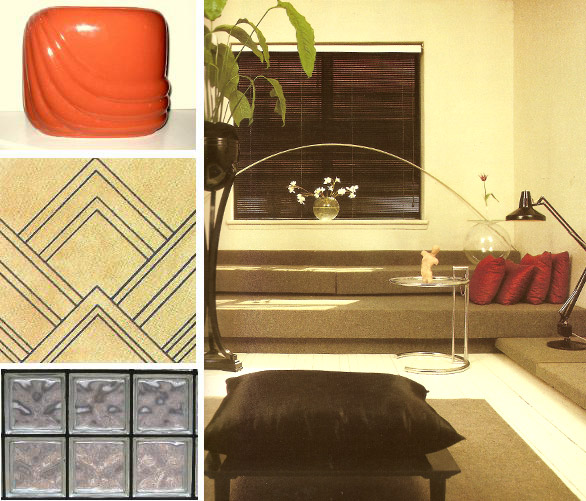1970’s
and 80’s Interior Design Context
1970’s
- · Amidst an oil crisis and rising inflation, interior design changed to reflect a new regard for nature and an awareness of environmental concerns.
- · The 1970s “Mod” look was inspired by movements in technology and science. Space Age technologies and the availability of new materials resulted in the creation of many stylish and innovative design trends that are popular again today.
- · Trendy colours were bright green, turquoise, sunshine yellow, orange and brown. White was used everywhere – in furniture as well as for backgrounds to offset brighter colours.
- · Strong uses of black and white were often accented with a bright colour by use of pillows, accent chairs and other fixtures.
- · Popular materials were Lucite, glass, vinyl, and leather, as well as metal, chrome and wood. Chrome and glass created a clean, space age look. Plastic became an acceptable material for furniture, and beanbag chairs became a trend for relaxed seating.
- · Furniture design ranged from stark, Scandinavian and Bauhaus to organic shaped plastics, vinyl and fabric chairs. Faux fur was used as a radical new material for upholstery. Wicker furniture and rattan peacock chairs were the rage when going for a more hippie, bohemian look.
- · Built-in desks, beds (including bunk beds) and seating were very common, as well as floor pillows for comfortable seating on the floor.

David Nightingale Hicks
Designer David Hicks dominated the 70′s interior design world
with eye popping patterns, colour and texture.
By the ’70s, David Hicks was a brand; his company was making
wallpaper, fabrics, and linens and had outposts in eight countries, including
the U.S. where he worked with the young Mark Hampton, and where his wallpaper
was used in the White House.
1980’s
- · In the ’80s, a modern look often reflected the “less is more” approach, with minimalist spaces showcasing clean-lined furniture. Reflective surfaces, achieved with materials like mirror, chrome and glass, were used to visually enlarge a room.
- · Interior design in the early 80s reacted to the floral designs of the 70s. Out went garish floral prints and bright colours. Instead, homes were decorated in more neutral tones.
- · Grey was a popular unifying hue, as colourful artwork popped on grey walls, while dark, muted colours could combine with grey tones to reinforce a stark, modern look.
- · Interior design in the 1980’s reflected the postmodern era. It followed the ideas of eclecticism and disorder.
- · Another design trend that re-entered the scene: Historicism. In the immediate post-World War II period, the design world was all about abandoning European precedents and establishing a home-grown design look with references to Victoriana styles.
- · Art Deco was also revived in the 80’s. Clean-lined fonts with modern curves were prominent, but angles and ’20s/’30s-inspired arches also infiltrated the world of interior design. This trend became popular alongside TV series like Miami Vice which embodied the glamorous and mysterious style.
- · The implementation of Margaret Thatcher’s ‘right to buy’ scheme in 1980 signalled a watershed for the British home-owner and interior design. Millions of new home-owners realised they had the freedom to decorate their homes as they wanted and at first, the response was reactionary.

Photos from "One room living" by Sue Rowlands 1977



No comments:
Post a Comment